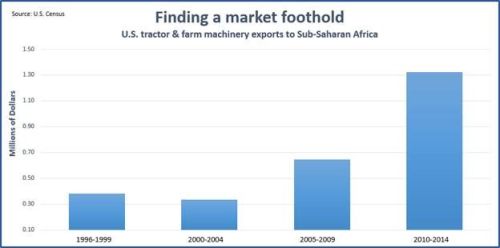WASHINGTON, Oct. 28, 2015 - Export statistics and the opinions of some American agricultural equipment dealers suggest U.S. Trade Development Agency (USTDA) tours that bring farmers from East and South Africa to the U.S. to show off American products on their home turf are working as intended.
Long-term growth in farm equipment sales to these regions have had to overcome substantial hurdles in recent years:
Against such constraints USTDA
conducted its fourth “reverse trade mission” into the U.S. Corn Belt and
Northern Plains since 2010, ushering large-scale African farmers and
agribusiness operators to conferences and individual meetings this summer with
equipment dealers and other ag companies and service providers.
USTDA estimates its Sub-Saharan reverse
missions each foster about $10 million in U.S. exports. But Peoples says the
results are very hard to score because, first, “it takes [the African buyers]
at least 18 months, maybe 36 months, before they make a purchase.”
Also, in Africa’s emerging economies,
customers’ identities change along with the rapid shifts in ownership and
organization of agribusinesses, he notes. Nonetheless, since a recent mission
in August, “there have been a great deal more equipment lists and bidding
proposals between the delegates and the [U.S.] companies than there has ever
been after the previous missions. So I’m cautiously optimistic.”
 Demand from Africa is primarily for
used farm machinery that’s been well maintained and remains in excellent
condition, Peoples says. Potential buyers are very leery of “buying used,” he
explains, so they need to visit U.S. dealerships and examine the machines
themselves. Also, the preference for top-quality used units means fewer are available
for the foreign markets when American farming profits plunge, he says, and
fewer are thus being traded in for new machinery.
Demand from Africa is primarily for
used farm machinery that’s been well maintained and remains in excellent
condition, Peoples says. Potential buyers are very leery of “buying used,” he
explains, so they need to visit U.S. dealerships and examine the machines
themselves. Also, the preference for top-quality used units means fewer are available
for the foreign markets when American farming profits plunge, he says, and
fewer are thus being traded in for new machinery.
Don Aberle, Titan Machinery
dealer in Moorhead, Minnesota, says his African sales are mostly used
equipment, and “it has to be in good condition.” He says he has developed a
clientele along with a list of more than 4,000 farm-related email addresses in
southern Africa and has found some success in selling used tractors, combines,
sprayers and other machines there in the past decade. Though he is making very
few sales there this year, “when the dollar turns around, we’ll do fine,” he
says.
Meanwhile, Randy George, foreign sales
manager for Nebraska-based T-L Irrigation Company, says USTDA has included his firm in
its Sub-Saharan Africans tour in each of the past three years, “and, as far as
I’m concerned, they could come every week.” The tours bring “the cream of the
crop” of African ag operations, he says, and the August tour has generated some
potential sales of irrigation systems in Botswana and Angola.
Tom Hardy, USTDA spokesman, says the
agency expects to continue the reverse trade missions for U.S. ag equipment
sales to southern Africa. Also planned is a reverse trade mission to expand
refrigerated shipping and storage of perishable U.S. farm products to that
region, perhaps in 2016.
USTDA is an
independent government foreign assistance agency that is funded by Congress.
It’s mission is to help create U.S. jobs through the export of U.S. goods and
services for priority development projects in emerging economies.
#30
For more news, go to: www.Agri-Pulse.com

